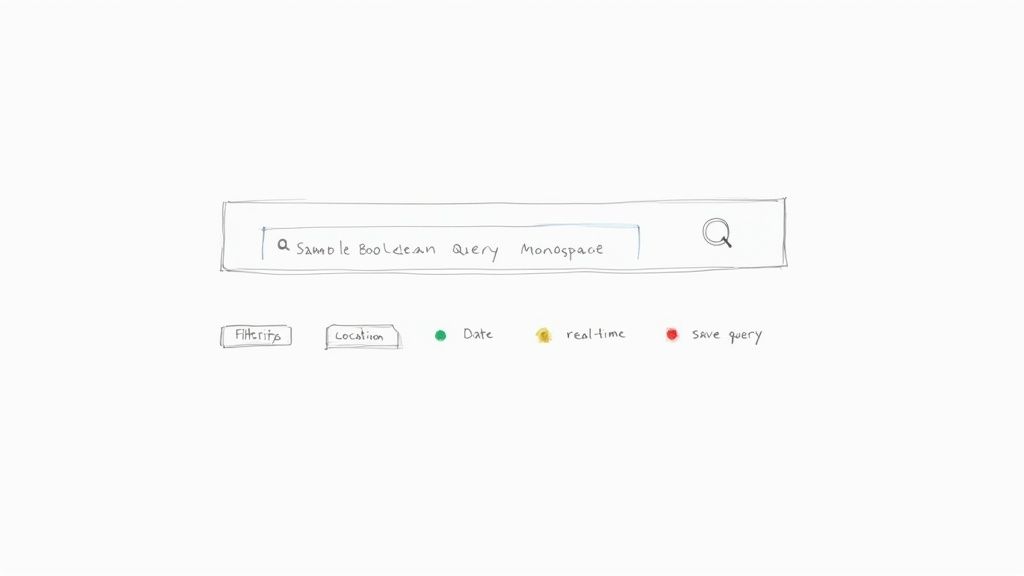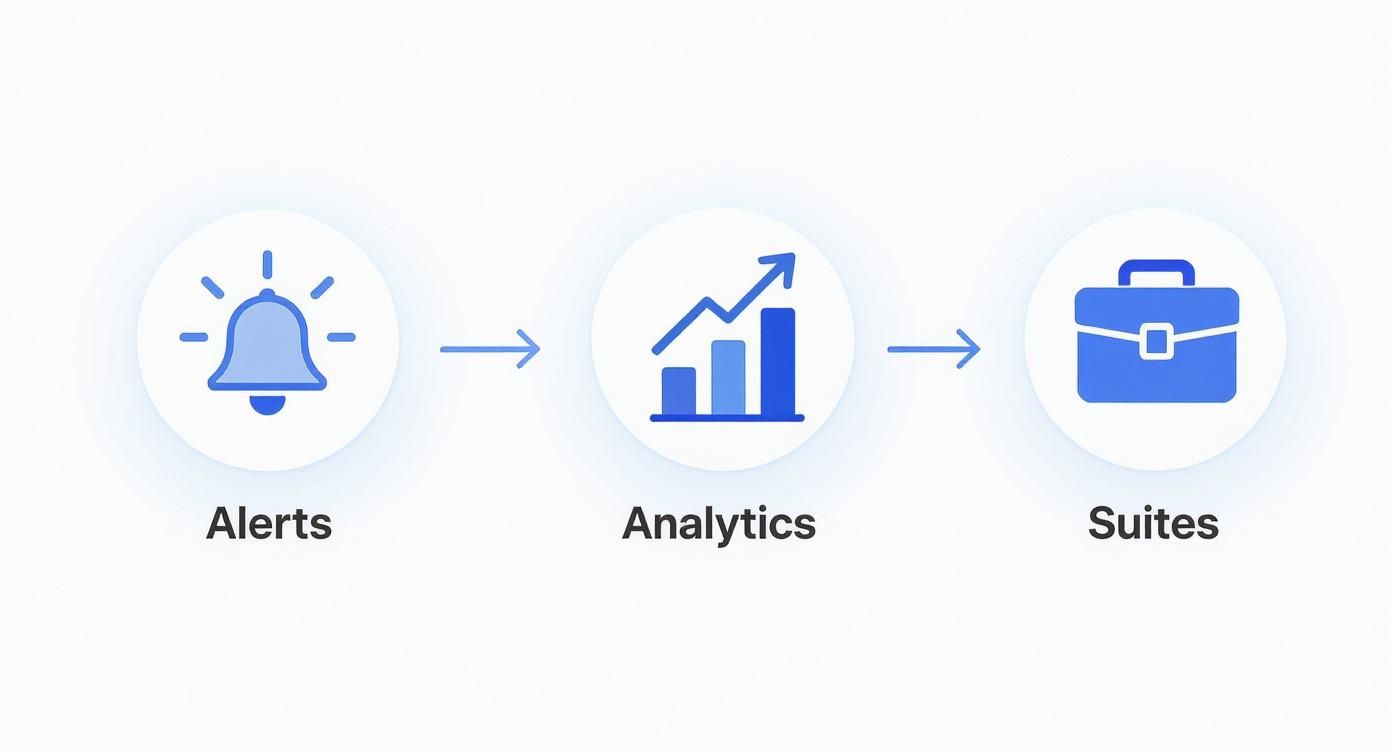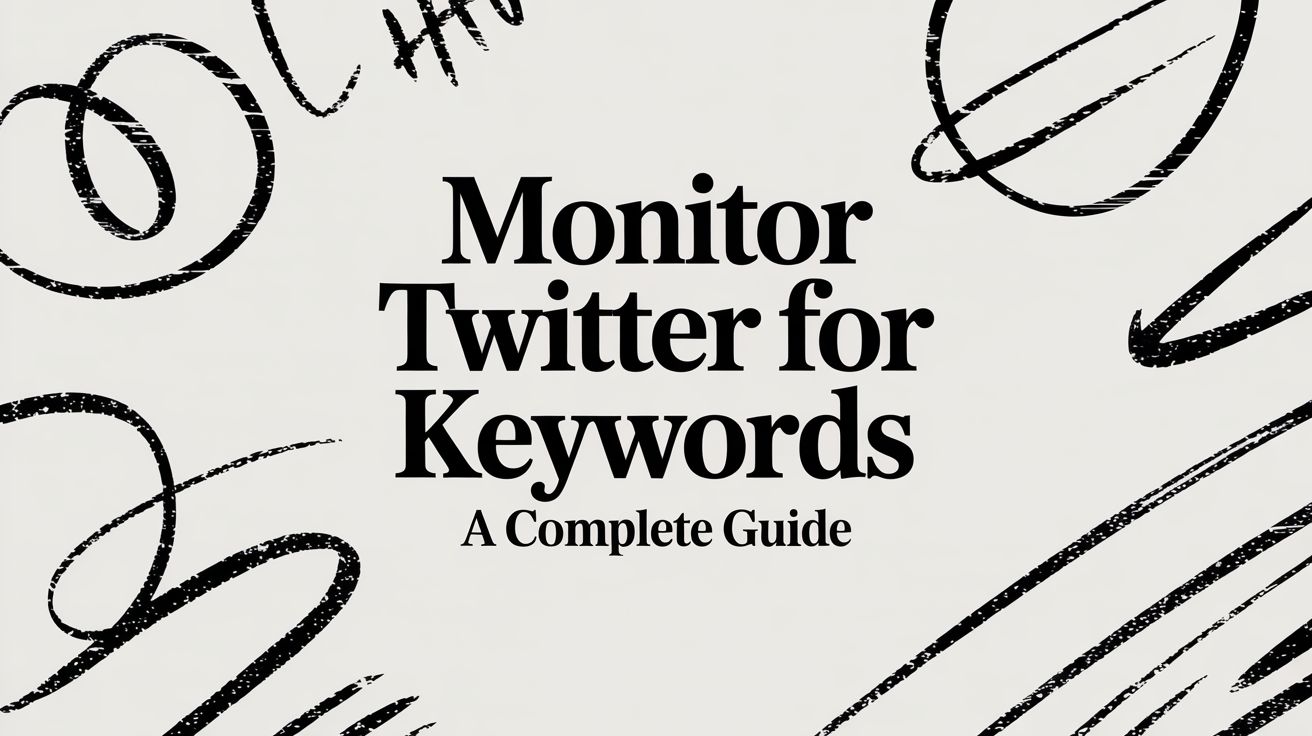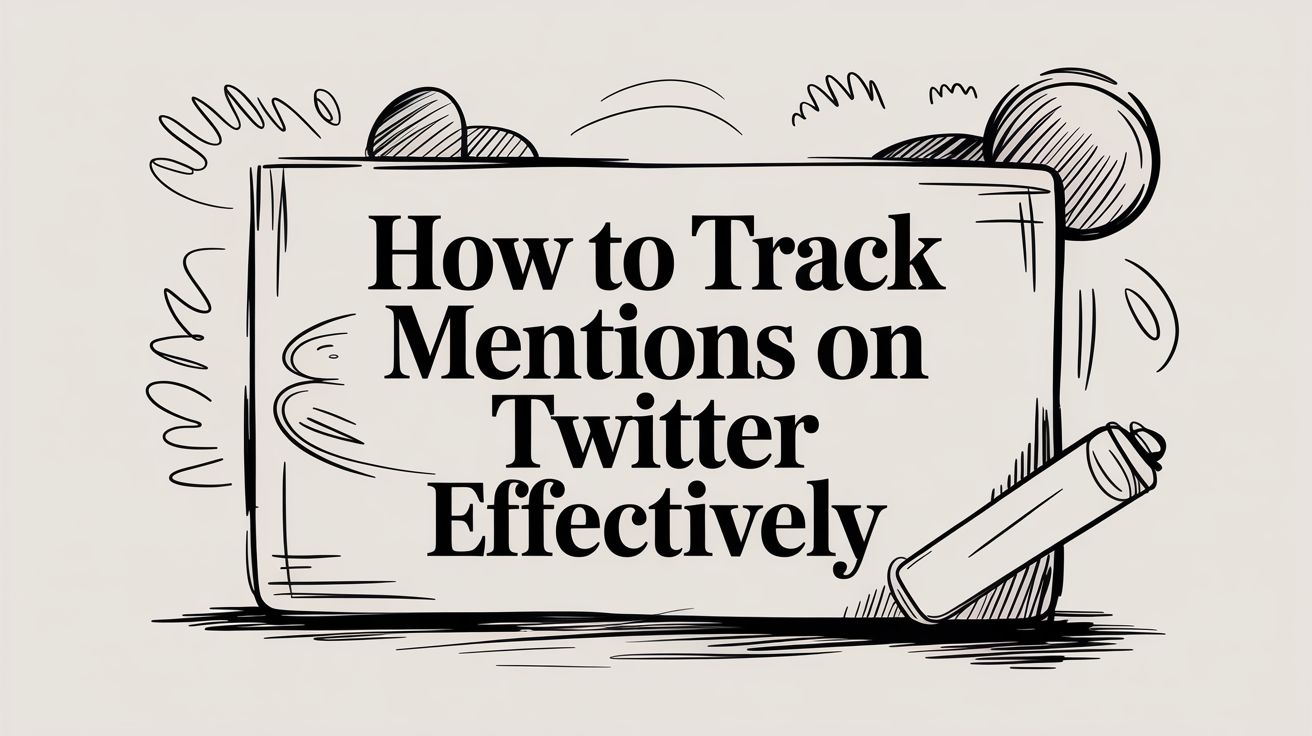Keeping a close watch on keywords on Twitter (now X) is like plugging directly into the global consciousness. It’s about using the platform’s own search features or specialized tools to follow specific words and phrases, turning an endless stream of conversation into solid business intelligence.
Why You Should Monitor Twitter for Keywords

Before we get into the nuts and bolts of how to do it, let's talk about why it's so valuable. Listening in on X gives you a direct line to raw, unfiltered public opinion. It's not about chasing vanity metrics; it's a goldmine of real-time data for anyone in marketing, research, or brand management.
With a staggering 335 million monthly active users worldwide, the platform is a massive focus group that never sleeps. Tracking the right keywords here lets you tap into public sentiment, see what's trending, and keep an eye on what the competition is up to.
Uncover Strategic Business Opportunities
The insights you can pull from keyword monitoring aren't just for your social media team—they can fuel opportunities across the entire company.
- Proactive Customer Service: Spot and solve customer problems before they blow up. When someone tweets, "Anyone know a fix for [your product] bug?" that's your cue to jump in, offer help, and show you care.
- Genuine Sales Leads: You can find people who are actively shopping for what you sell. A post like, "What's the best software for [your industry]?" is a warm lead asking to be engaged.
- Unfiltered Competitive Intelligence: See exactly what people love (and hate) about your competitors. Following their brand mentions can highlight their weaknesses and reveal service gaps your business can fill.
Consistently monitoring the right keywords moves you from a reactive to a proactive strategy. You stop guessing what your audience wants because you’re hearing it straight from them, every single day.
Ultimately, to monitor Twitter for keywords is to build a smarter, more customer-focused business. The benefits of social media monitoring are huge, giving you a clear advantage in managing your reputation, finding new leads, and making decisions based on real data. Now, let’s get into how you can set this up.
Using Twitter's Own Search Tools Like a Pro

Before you pull out your credit card for a fancy monitoring tool, it's worth getting your hands dirty with the powerful features X (formerly Twitter) already gives you for free. The standard search bar is really just the tip of the iceberg. The real power is in the advanced search operators.
Think of these operators as your secret weapon. They let you build incredibly precise queries that cut through the noise and zero in on the conversations that actually matter to your business.
For instance, a simple search for your product name will probably pull up a messy mix of useful feedback, spam, and irrelevant chatter. But by tacking on a few operators, you can build a search that only shows you, say, negative-sentiment tweets about your competitor from users in a specific city. Suddenly, you've turned a simple search bar into a surgical tool for market research.
Mastering Advanced Search Operators
The best way to get a feel for this is to just jump in and try it. Advanced operators let you combine, exclude, and filter terms to radically improve your results. I like to think of them as LEGO blocks for building the perfect search query.
Here are a few of the most useful operators you can start playing with right away:
"exact phrase": Putting your query in quotes tells X to look for that exact combination of words. It's a must-use for tracking brand names, slogans, or specific product features.OR: This one's great for broadening your net. A search like("customer service" OR "help desk")will catch mentions of either term, so you don't miss anything.-(minus sign): This is your exclusion filter. If your company is named "Apollo" and you’re tired of seeing tweets about the Greek god, you could search for"Apollo" -god -mythology.to:username: This finds all the replies sent directly to a specific account. I use this all the time to see how people are talking to competitors.from:username: On the flip side, this shows you every tweet sent from a particular account.
The real magic happens when you start chaining these together. You can craft some seriously complex queries to find hyper-specific conversations, like uncovering customer service complaints aimed at a rival that don't mention your own brand.
If memorizing syntax isn't your thing, the visual Advanced Search interface makes this a lot easier by giving you dedicated fields for each filter.

As you can see, the layout is clean and translates what you type into those complex search strings automatically. It's a great way to learn the syntax without having to commit it all to memory from day one.
Practical Scenarios for Native Search
Let’s make this real. Imagine you work for a company that sells a project management tool, and you want to find people who are actively looking for a solution like yours.
A simple search for "project management" would be a firehose of noise. Instead, you could get clever and build a query like this: ("any recommendations" OR "looking for a tool") AND ("project management" OR "task manager") -filter:replies.
This query is designed to find original tweets—not replies to other threads—where someone is asking for help finding the exact type of software you sell. It’s a simple but effective way to find warm leads.
For a much deeper dive into these kinds of strategies, our guide on how to track mentions on Twitter walks through even more advanced examples. Once you get the hang of these native tools, you'll have a rock-solid foundation for your monitoring efforts.
Choosing the Right Third-Party Monitoring Tools
Sooner or later, you’ll hit the limits of what you can do with native search and TweetDeck. When manual searches start feeling like a full-time job, it's time to bring in the pros: third-party monitoring tools. These platforms offer the automation, deep analytics, and raw efficiency you simply can't achieve by hand.
But let's be honest, the market is a jungle. It's easy to get lost in flashy feature lists and marketing hype. The secret is to tune out the noise and zero in on what you actually need to accomplish. Are you trying to pounce on customer service fires the second they ignite? Or are you digging for long-term strategic insights? The perfect tool for a local coffee shop is worlds away from what a global enterprise needs to manage its brand reputation.
Categories of Monitoring Tools
To make sense of the options, it helps to group them by what they do best. Forget the brand names for a second and think about the job to be done. This way, you can match a tool’s core strengths to your specific goals and avoid paying for a bunch of features you'll never touch.
- Real-Time Alerting Tools: Think of these as your digital smoke detectors. Their entire purpose is to send you an instant notification when your keywords pop up. They’re indispensable for urgent tasks like customer support, PR crisis management, and catching hot leads.
- In-Depth Analytics Platforms: These are built for the strategists and data nerds. They move beyond just tracking mentions to give you the "why" behind the conversation—sentiment analysis, share of voice against your competitors, and identifying key influencers.
- All-in-One Social Media Suites: These are the Swiss Army knives of social media. They bundle monitoring with publishing, scheduling, and community management into a single dashboard. They're a solid choice for teams that wear a lot of hats, from creating content to engaging with followers.
When you're ready to look beyond Twitter's own ecosystem, a great starting point is exploring some of the best online reputation management software tools, as many have powerful social listening capabilities built-in.
Must-Have Features to Look For
No matter which category you're leaning toward, some features are simply non-negotiable if you’re serious about how you monitor Twitter for keywords. Thankfully, the tools have come a long way. Top-tier platforms offer things like real-time notifications, geographic filtering, and the kind of sophisticated Boolean search you'd expect from a research database. For instance, a tool like Twilert shines with its advanced geo-targeting, letting you pinpoint tweets from a specific city or even a single event venue—a massive advantage for local marketing.
As you start comparing, keep an eye out for these fundamentals:
- Boolean Search: The power to build laser-focused queries using operators like AND, OR, and NOT. This is crucial for cutting through the noise.
- Sentiment Analysis: Automated sorting of mentions into positive, negative, or neutral buckets. It’s not always perfect, but it gives you a quick pulse check.
- Influencer Identification: A feature that automatically flags accounts with real reach and authority who are talking about you or your industry.
- Reporting and Dashboards: You need clear, customizable reports that let you visualize trends and easily share key findings with your team or boss.
The goal isn't to find the tool with the most features, but the one with the right features for your workflow. An overly complex platform can be just as counterproductive as one that’s too basic.
Comparison of Twitter Monitoring Tool Features
To help you visualize how these different tool types stack up, here’s a quick comparison of their core strengths. This can help you narrow down which category to explore first based on your primary monitoring goals.
| Feature | Real-Time Alerting Tools (e.g., Twilert) | Analytics Platforms (e.g., Brand24) | All-in-One Suites (e.g., Sprout Social) |
|---|---|---|---|
| Speed | Instant, near real-time | Near real-time to hourly | Varies; often hourly or slower |
| Primary Use Case | Crisis management, lead gen, support | Market research, brand health | General social media management |
| Historical Data Access | Limited | Extensive | Moderate to extensive |
| Sentiment Analysis | Basic to moderate | Advanced, with trend analysis | Moderate |
| Publishing/Scheduling | No | No | Yes, fully integrated |
| Reporting Depth | Basic (mention lists, volume) | Deep (competitive, share of voice) | Comprehensive (engagement, performance) |
Ultimately, the best tool is the one that fits seamlessly into your process and provides actionable information, not just a mountain of data.
Choosing the right platform is a big decision that directly affects your team’s efficiency and the quality of your insights. For a much deeper dive, check out our social listening tools comparison to see how different options compare head-to-head.
Setting Up a Workflow That Actually Works
Let's be honest, collecting mentions is the easy part. The real work is turning that firehose of data into something you can actually use. Without a smart workflow, you'll drown in noise and miss the conversations that could make or break your quarter.
A good system makes sure the right person sees the right mention at the right time. This isn't about creating some massive, complicated flowchart; it's about building a simple, repeatable process that your team can stick to. The goal is to shift from just listening to actively engaging and turning those keyword alerts into real business results.

This graphic nails a key point: your workflow should dictate the tools you choose, not the other way around. Figure out what you need to do first, then find the tool that helps you do it.
Triage and Assign Every Mention
Not all mentions are created equal. A tweet from a customer whose account is locked is worlds apart from someone giving a casual shout-out. The first, and most critical, step is triage—quickly sorting every mention into a predefined bucket.
Create a dead-simple tagging system that anyone on your team can understand. Most monitoring tools let you use labels or tags right in the dashboard. For instance, you could use:
Urgent-Support: For fires that need putting out, like bugs or service outages.Sales-Lead: For anyone signaling they're ready to buy (e.g., "anyone know a good alternative to [competitor]?").Feedback-Product: For user suggestions or feature requests.PR-Mention: For tweets from journalists or high-follower accounts.
Once a mention is tagged, it needs a clear owner. Urgent-Support tags should ping your customer success team immediately. Sales-Lead tags? Straight to the sales reps. This simple handoff cuts out the confusion and slashes your response times.
A solid triage process is what separates controlled, professional social media management from chaotic firefighting. It guarantees your most important conversations get handled first, every single time.
Set Up Alerts That Don’t Drive You Crazy
Nothing leads to burnout faster than constant, useless notifications. An intelligent alert system cuts through the chatter and only pings you for things that genuinely need your immediate attention. Thankfully, most third-party tools give you granular control over this.
Set up instant alerts for your "oh-no" keywords—the ones that signal a crisis or a golden opportunity. Think terms like "outage," "broken," "scam," or any mention from a VIP list of media outlets. For everything else, use scheduled digests. A daily email summary of general brand mentions is usually all you need to keep a finger on the pulse without overwhelming your team.
Create a Simple Response Matrix
To keep your brand voice consistent and ensure every interaction is handled perfectly, build a simple response matrix. This is just a cheat sheet that outlines who responds, how quickly, and with what kind of tone. It doesn't need to be some 50-page brand bible; a simple table gets the job done.
| Mention Type | Who Owns It | Response Time Goal | Tone & Voice | What to Do (Example) |
|---|---|---|---|---|
| Urgent Support | Support Team | < 15 minutes | Empathetic, helpful | Acknowledge the problem, create a support ticket. |
| Sales Lead | Sales Team | < 1 hour | Informative, no hard sell | Answer their question, offer a helpful resource. |
| Positive Feedback | Marketing Team | < 8 hours | Appreciative, friendly | Thank them, ask a follow-up question. |
| Competitor Mention | Marketing Team | Discretionary | Neutral, observant | Monitor the conversation; don't jump in. |
This kind of framework empowers your team to act decisively when they monitor Twitter for keywords. They'll know exactly what to do, which means they can respond with confidence and consistency every single time.
Turning Monitoring Data into Actionable Insights
Collecting a ton of brand mentions is great, but it's only half the battle. The real magic happens when you turn that firehose of raw data into a clear story about what’s working, what isn't, and where you should go next.
When you're monitoring Twitter for keywords, you're essentially conducting live market research. The challenge is moving beyond just counting mentions and connecting the dots to prove your efforts are actually paying off, especially when you have to report back to leadership.
Key Metrics to Measure and Report
To show the real return on your investment, you need to build a narrative with solid numbers. I recommend focusing on a few core areas that directly tie social chatter to tangible business outcomes.
- Mention Volume Over Time: Keep a close eye on the daily or weekly volume for your keywords. You'll quickly see how spikes line up with marketing campaigns, product updates, or news cycles, giving you a real-time view of your impact.
- Share of Voice (SoV): How much of the conversation are you owning compared to your top 2-3 competitors? If your SoV is climbing, that’s a powerful sign that your brand awareness and market presence are growing.
- Sentiment Analysis: Don't just settle for a simple positive/negative score. The real insight comes from tracking the change in sentiment. Did that new feature launch cause a 15% jump in positive mentions? That's a huge win and something concrete to share with the team.
These numbers aren't just for looking good in a report; they're your guide for optimizing strategy. Tracking things like impressions, engagement rates, and how specific hashtags perform tells you exactly where to put your time and money. For instance, you might discover one hashtag drives way more traffic than another, which is critical information for planning your next campaign. If you want to dive deeper, there are plenty of valuable metrics for Twitter on trackmyhashtag.com.
From Data Points to Strategic Actions
Ultimately, the goal is to make these insights a catalyst for action across the entire company. Every piece of data should answer the question, "So what?" and point to a clear next step.
Don't just report on what people are saying. Report on what it means for the business and what you’re going to do about it. That’s how you turn a monitoring report from a simple summary into a strategic document.
A sudden flood of negative comments about a specific feature isn't just a blip on a chart; it's a direct signal to the product team that something needs immediate attention.
By that same token, spotting users asking for alternatives to a competitor is a hot lead for your sales team. This is where concepts like Signal-Based Selling come into play, helping you turn what you're hearing into an intelligent sales pipeline. When you connect these dots, monitoring transforms from a passive listening exercise into a proactive engine for growth.
Answering Your Top Questions About Monitoring Twitter Keywords
Getting started with Twitter monitoring always brings up a few questions. Once you get past the basics and start thinking about how this applies to your business, you’ll naturally wonder about the best tools, the right budget, and the smartest way to approach it all.
Let's clear up some of the most common questions I hear so you can build a strategy that actually works.
Can I Really Monitor Keywords Without a Paid Tool?
You absolutely can. You don't need to shell out for an expensive subscription right away. Honestly, Twitter's own Advanced Search is a pretty powerful feature for manual keyword monitoring if you know how to use it. It lets you construct some surprisingly complex searches, filtering by everything from exact phrases and specific accounts to dates and even locations.
Of course, you won't get the real-time alerts or slick, automated reports that come with paid software. But it's the perfect place to start. If you're running a small business, a solo venture, or just dipping your toes into social listening, checking in with Advanced Search a few times a day will give you a ton of valuable insight without costing a dime.
How Do I Stop Drowning in Irrelevant Mentions?
This is probably the biggest headache when you monitor Twitter for keywords: getting clean, relevant data. The trick isn't just finding mentions, it's about filtering out the junk. Your best friend here is the negative keyword.
Let's say your brand is called "Oasis" and you sell hydration packs. You’re going to be swimming in mentions of the band. A smart query would actively exclude all that noise: "Oasis hydration" OR "Oasis packs" -band -music -Noel -Liam. See the difference?
The quality of your monitoring results is directly tied to the quality of your search query. A few extra minutes spent adding negative keywords and using exact-match phrases will save you hours of sifting through irrelevant noise later.
Don't forget to use quotation marks for exact phrases, like "customer support issue". This simple tweak dramatically improves relevance. The more specific you get upfront, the cleaner your results will be.
I've Collected the Data... Now What?
Gathering mentions is easy. The hard part is doing something meaningful with them. The real magic happens when the insights you uncover are put to work across your entire company. Your monitoring feed should be a central intelligence hub, not just a marketing tool.
Here’s how you can turn that data into real action:
- For Product Development: Every feature request, bug report, and piece of product feedback should go straight to your dev team. They get raw, unfiltered user perspectives that help them build a better product.
- For the Sales Team: Spot someone looking for an alternative to a competitor? That's not just a mention; it's a warm lead. Pass it directly to your sales folks for a timely follow-up.
- For Customer Support: All those complaints and support issues are a roadmap for improving your service. This is priceless feedback for boosting customer satisfaction and keeping people around.
- For Content Strategy: Notice what topics keep coming up? What are the most common questions people ask in your niche? That's a goldmine of ideas for blog posts, videos, and guides your audience is practically asking for.
The worst thing you can do is let these insights get stuck in a silo. When you weave this data into the daily work of other teams, it becomes a serious engine for growth.
Ready to turn social conversations into real growth without the manual work? Replymer acts as your done-for-you growth team. We monitor the right keywords 24/7, and our expert writers craft authentic replies that recommend your product in the right conversations on X, Reddit, and LinkedIn. Start growing on autopilot.



